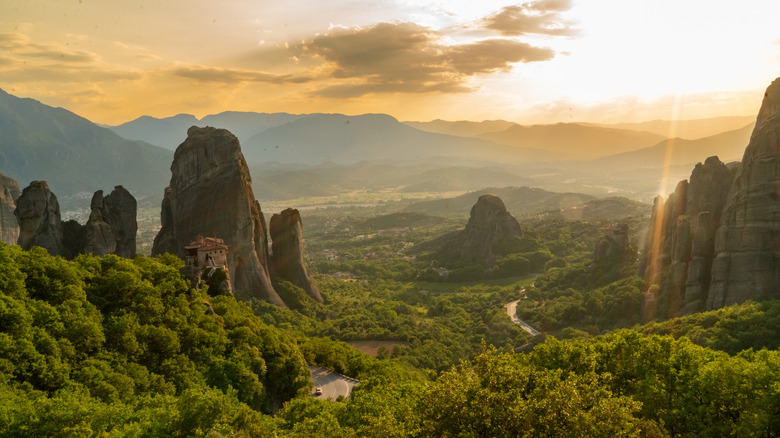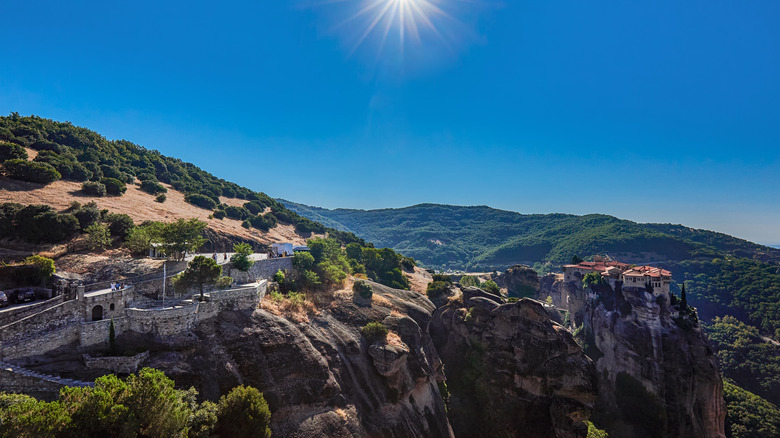One Of Samantha Brown's Favorite Greek Destinations Is Packed With Dramatic Hikes And Divine Views
Greece's islands are undeniably worth visiting for a laid-back vacation full of culture and good food. Travel icon Samantha Brown has learned this from her many visits and says that islands make up four out of seven of her all-time favorite Greek destinations. Also gracing Brown's list are the nation's capital, Athens, and Thessaloniki, Greece's underrated second-largest city. Another place Brown says she adores isn't even a town at all; in fact, it's relatively out of the way and quite small . Nevertheless, Meteora, a UNESCO World Heritage Site with towering cliffs and stunning churches, made it to her list of her seven favorite places in all of Greece.
Situated in the north of Greece's mainland, around 200 miles from Athens, Christian monks inhabited Meteora from as early as the 11th century, building their first settlement at the base of the area's iconic, towering rock formations. However, the threat of conflict moved the settlers upward, onto the flat tops of the rocks. Here, they built Great Meteoran, the area's oldest monastery, in the mid-1300s. They continued to build more and more monasteries on the rocks until, at one point, there were 24 in all. Although just six remain open, these monasteries are a must-visit for their reflective atmospheres and incredible panoramic views of the surrounding landscapes. As Brown puts it, "This place forces you to slow down and take it all in," via Parade.
There are a few ways to get to Meteora, but if you're coming from the U.S., flying into Athens International Airport will be the most convenient. European travel influencer Rick Steves would agree that this would be an appropriate beginning, as he reckons that Athens is the best city to start your Greek vacation. Once you're in Athens, rent a car, and drive about 3.5 hours northwest to reach Kalabaka, the closest town to the monasteries, located at the base of the rocks.
Explore Meteora on foot for the most amazing views
Note that the six Meteora monasteries that welcome visitors today all have slightly different operating hours. If you want to visit them quickly, then you can drive; however, a fun way to experience this blend of natural and human-made phenomena is by hiking. There are a few routes that wind up and around the rocks from town, with some that take you past the best viewing points. These treks can range from one to four hours of just walking time; make sure you also factor in time to appreciate the wonderful, hidden architectural features of the buildings as well as their interiors, several of which have interesting museums. Also, be sure to include plenty of time for admiring the views.
If you don't want to trek all the way up to the monasteries, the surrounding area has many less challenging and more horizontal walks, though most do have some hilly sections, as it's a mountainous area. This includes a half-mile trek to the Meteora Digital Projection Center, a heritage museum that has captured the beauty and history of the monasteries in 3D films.
Regarding how to prepare for adventures in and around Meteora, Samantha Brown avers that understanding the terrain and weather at your destination will make preparations easier. She says she asks herself questions such as, "What will the paths look like? ... are there going to be a lot of uneven sidewalks or cobblestone paths?" (per her article on her website, Places to Love). Previous visitors have mentioned how steep and muddy the trails can be around Meteora, so make sure you pack all of your walking essentials, including sturdy footwear, water, sun protection, and a waterproof jacket. Entrance to each monastery is three euros ($3.50), and, as these are religious sites, you must dress modestly to be allowed entry.

